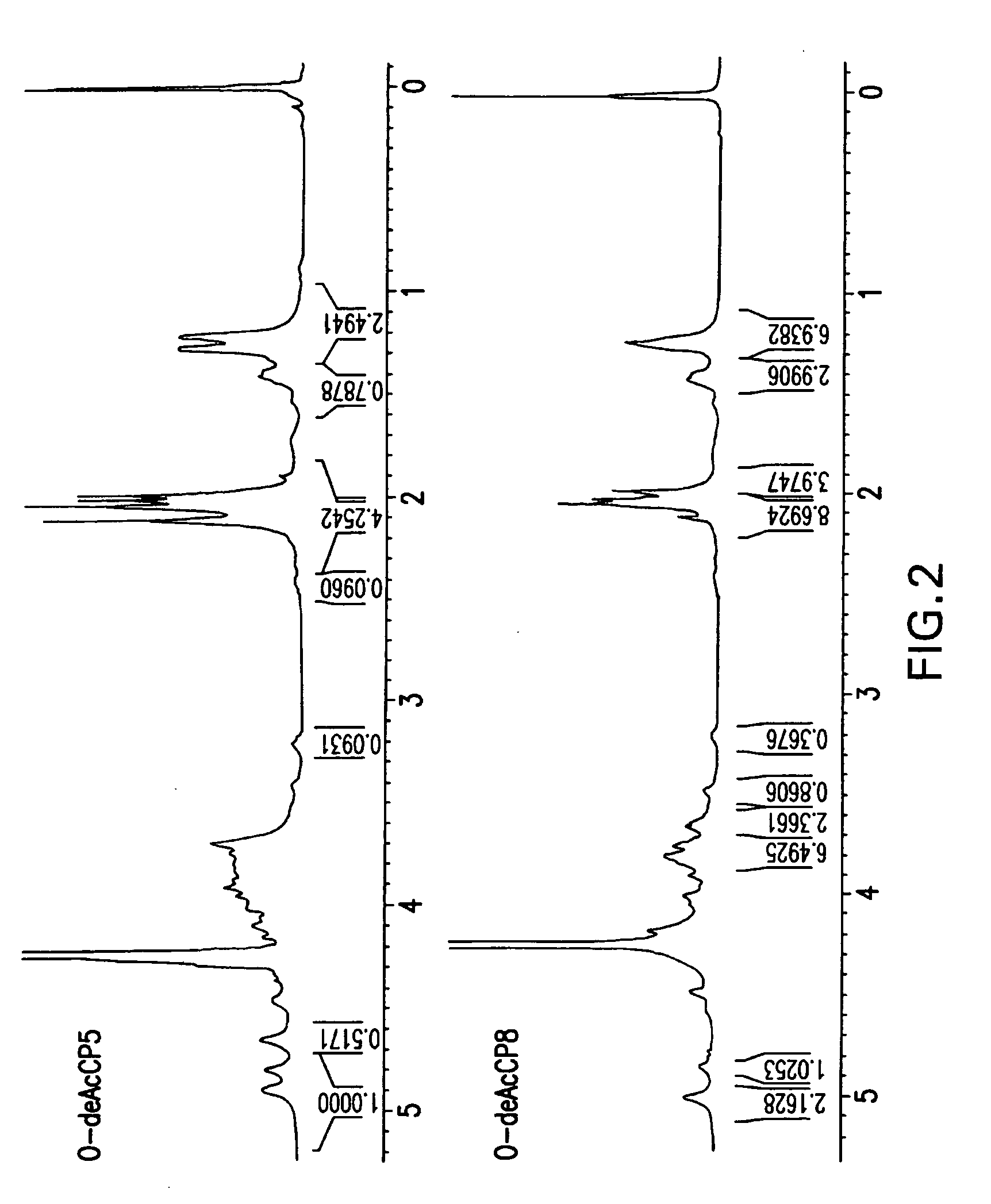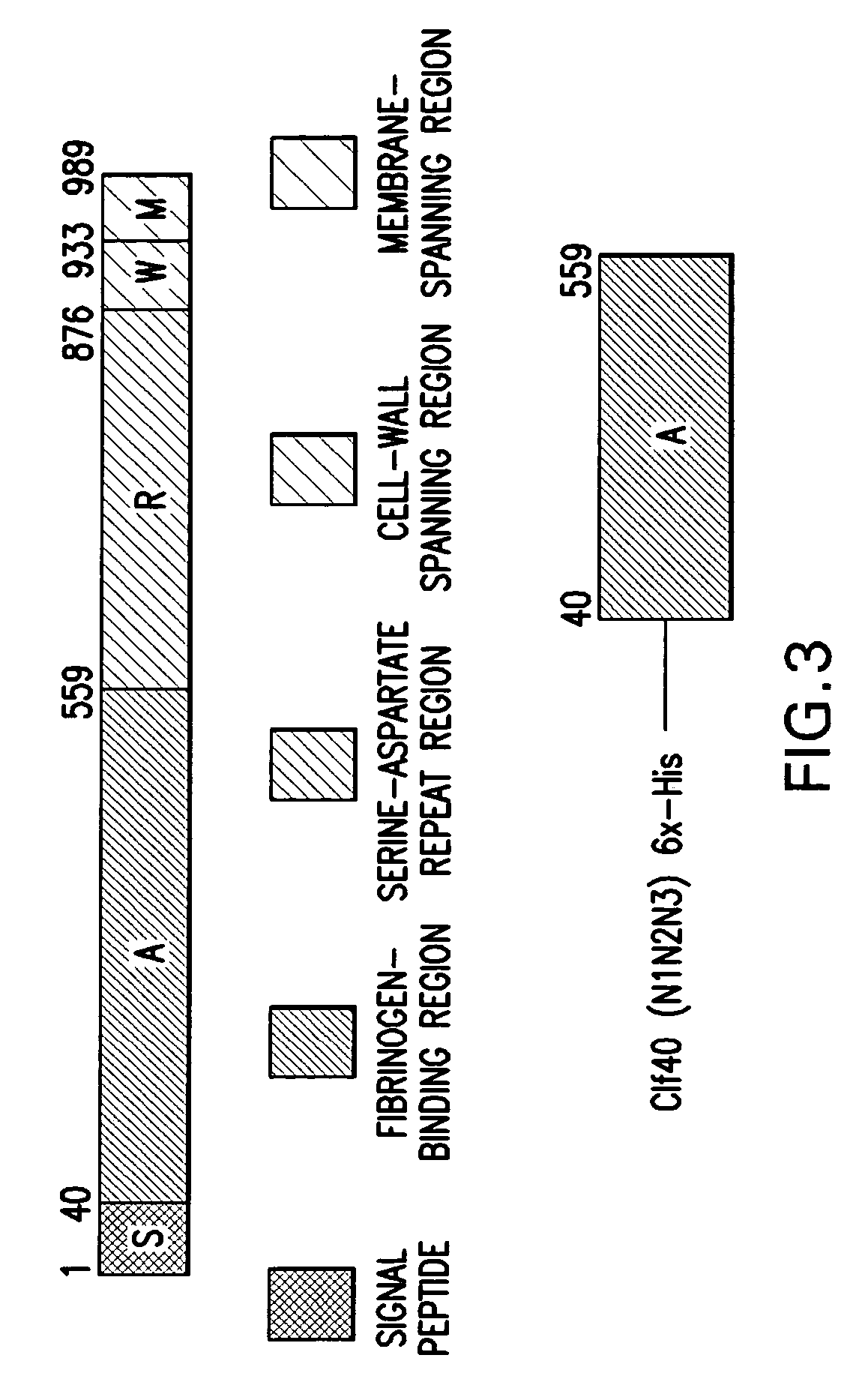Polysaccharide-staphylococcal surface adhesin carrier protein conjugates for immunization against nosocomial infections
a technology of polysaccharide and staphylococcal surface, which is applied in the field of immunogenic polysaccharideprotein conjugates, can solve the problems of no immunogenic composition effective for treating or preventing nosocomial infections, and design even more difficul
- Summary
- Abstract
- Description
- Claims
- Application Information
AI Technical Summary
Benefits of technology
Problems solved by technology
Method used
Image
Examples
example 1
Purification of the S. aureus CP5 and CP8 Polysaccharides
[0112]S. aureus strains Lowenstein (ATCC#49521) and Wright (ATCC#49521) were used for purification of CP5 and CP8, respectively. The polysaccharides were purified from the cells by the methods modified from those published previously (Fournier, Vann et al. 1984; Fournier, Hannon et al. 1987). Cells grown in Columbia broth, supplemented with 2% NaCl were digested for 3 hrs at 37° C. with lysostaphin (175 U / g of cells), RNAse, and DNAse (0.1 mg / g of each) for 4 hrs at 37° C., followed by digestion with pronase (1 mg / g of cells) for 3 hrs at 37° C. The crude CP was prepared from enzymatic digest by sequential precipitation with 25% and 75% ethanol in the presence of 10 mM CaCl2 The CP was then purified from the pellet by anion-exchange chromatography on a Q-Sepharose column using a linear gradient of 0.05-0.5 M NaCl. The residual teichoic acid was oxidized with 0.05M NalO4. After dialysis the CP was then further purified by size...
example 2
Analysis of S. aureus CP5 and CP8
[0114] Chemical characterization of the purified CP5 and CP8 demonstrated that both polysaccharides were practically free of nucleic acids and residual protein (Table 1).
[0115] Sugar composition determined by HPAEC chromatography revealed the presence of FucpNAc and ManpNAcA in CP5 and CP8 (FIG. 1). 1H NMR spectra of O-deacetylated polysaccharides (FIG. 2) were similar to the spectra previously published (Vann, Moreau et al. 1987; Moreau, Richards et al. 1990), confirming the structure and presence of three monosaccharides: 2-acetamido-2-deoxy-D-mannuronic acid, 2-acetamido-2-deoxy-L-fucose and 2-acetamido-2-deoxy-D-fucose.
[0116] Purified CP5, CP8 and TA were immunologically distinct as confirmed by a single precipitin band in a double immunodiffusion assay when reacted with corresponding whole cell antisera (data not presented).
example 3
Purification of Surface Adhesin Proteins
[0117] The surface adhesin proteins evaluated were—[0118]S. aureus Clf40 (N1N2N3)—full length A domain of Clumping factor A (amino acids (M) 40-559)—FIG. 3. [0119]S. aureus Clf41 (N2N3)—post protease site fragment of Clf 40 (AA 223-559)—FIG. 4. [0120]S. epidermidis SdrG (N1N2N3)—full length A domain of SdrG (AA 50-597)—FIG. 5. [0121]S. epidermidis SdrG (N2N3)—post protease site fragment of SdrG (AA 273-597)—FIG. 6.
[0122] These surface adhesin proteins were obtained from Inhibitex, Inc., Alpharetta, Ga., USA.
[0123] Histag-minus versions of surface adhesin proteins were purified from the E. coli plasmid host strains. The E. coli pLP1134 BL21 (DE3) was used for S. aureus ClfA41 (N2,N3) and pLP1135 B21 (DE3) for S. epidermidis SdrG (N2,N3) purification. Both proteins were isolated from soluble fractions of cell lysate by ammonium sulfate precipitation and subsequent ion-exchange chromatography on a Sephacryl Q-Sepharose column (Amersham Pharmac...
PUM
| Property | Measurement | Unit |
|---|---|---|
| molecular weights | aaaaa | aaaaa |
| molecular weight | aaaaa | aaaaa |
| molecular weights | aaaaa | aaaaa |
Abstract
Description
Claims
Application Information
 Login to View More
Login to View More - R&D
- Intellectual Property
- Life Sciences
- Materials
- Tech Scout
- Unparalleled Data Quality
- Higher Quality Content
- 60% Fewer Hallucinations
Browse by: Latest US Patents, China's latest patents, Technical Efficacy Thesaurus, Application Domain, Technology Topic, Popular Technical Reports.
© 2025 PatSnap. All rights reserved.Legal|Privacy policy|Modern Slavery Act Transparency Statement|Sitemap|About US| Contact US: help@patsnap.com



